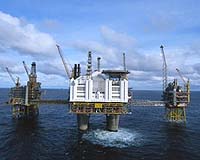 |
New Orleans, Louisiana (AFP) May 26, 2010 BP downplayed hopes for a bid Wednesday to cap an oil leak described as the worst in US history, as it carried out final tests on the plan to end the huge leak in the Gulf of Mexico. President Barack Obama piled pressure on the British oil giant ahead of the effort to seal a pipeline ruptured by a rig blast on April 22, announcing that he would make a second trip to the region since the crisis began. BP had previously talked up the "top kill" procedure, which involves smothering the leak with heavy drilling fluid then sealing it with concrete, but later warned that the technique had never been tried at such depth. BP CEO Tony Hayward said the chances of success were "somewhere between 60 percent and 70 percent." "If it was on land we would have a very high confidence of success, but... we need to be realistic about the issues around operating in a mile of water," Hayward said. Residents and officials are desperate for the company stop the spill, which has washed up on beaches and clogged fragile marshlands, with hundreds of thousands of gallons of oil a day speweing from the pipeline. Carol Browner, the top White House advisor on energy and environmental matters, said it was the worst spill in US history. "I don't think there's any doubt, unfortunately," she told ABC News. Fresh details of backstage anger at the White House emerged Tuesday as the impact of the spill became known last month, with famously calm Obama venting his frustration. "Plug the damn hole," Obama told aides in the week after the spill began, the Washington Post reported. US Energy Secretary Steven Chu was monitoring preparations for the new bid and told Obama in a phone briefing that BP was conducting "crucial diagnostic pressure tests" before proceeding, a White House statement said. The process was slated to begin early Wednesday, but BP senior vice president Kent Wells said the tests "could take 12-24 hours." "When the actual kill might go forward, the earliest might be tomorrow and that could extend on from there," Wells said. Oficials were also readying backup options but some, including the drilling of relief wells to divert the flow and allow the original well to be capped, could take several months. If the "top kill" cannot proceed, BP plans to lower a containment dome over the leak, sealing it in place to prevent the formation of crystals caused by cold sea water mixing with natural gas. Such crystals caused the failure of BP's first, similar attempt to contain the leak. Wildlife and shorelines across four US states are threatened by the spill, though Louisiana has so far borne the brunt of the disaster, with thick oil washing into its fragile marshlands, coating wildlife in crude. Residents expressed growing frustration at BP's failure to stop the leak and with the pace of the clean-up efforts, but the government maintains it lacks the equipment or expertise to step in. A fishing ban in the Gulf was meanwhile expanded by more than 8,000 square miles (20,000 square kilometers) Tuesday, closing off an area the size of Greece. In Biloxi, Mississippi, fishmongers said they had been forced to import shrimps from Alabama. "Most of the shrimpers are not allowed to go out," Sean Desporte told AFP. "A lot of clients... are asking if we've found oil in the shrimps." Political pressure was rising in Washington, where the Mineral Management Service, which regulates offshore drilling, came under new scrutiny after a Department of Interior report said staff members used illegal drugs, accepted gifts from oil companies and falsified inspection reports. Obama also raised the spill in meetings with Republicans, telling them it "should heighten our sense of urgency to hasten the development of new, clean energy sources," White House spokesman Robert Gibbs said. New hearings into the April 20 explosion on the BP-leased Deepwater Horizon rig were held in Washington, as lawmakers released details of a preliminary BP investigation that found multiple warning signs before the blast. Eleven people were killed in the accident. Representatives Henry Waxman and Bart Stupak said there were three worrying flow indicators from the well in the hour before the accident alone. But a series of problems were also detected in the 24 hours before the blast, including unexpected pressure rises and fluid leaks, flaws in cementing done to the well, and deviations by rig workers from a drilling plan.
Share This Article With Planet Earth
Related Links Powering The World in the 21st Century at Energy-Daily.com
 After oil, Norway should turn to gas
After oil, Norway should turn to gasStavanger, Norway (AFP) May 25, 2010 As Norway prepares for the day its massive oil reserves run out, industry players say natural gas is the best replacement, freely available and more efficient than renewables and less controversial than nuclear. "It's a battle between idealists and realists and it will not be an easy discussion. But gas will be part of the solution," said Brian Bjordal, who heads up Norwegian gas transport c ... read more |
|
| The content herein, unless otherwise known to be public domain, are Copyright 1995-2010 - SpaceDaily. AFP and UPI Wire Stories are copyright Agence France-Presse and United Press International. ESA Portal Reports are copyright European Space Agency. All NASA sourced material is public domain. Additional copyrights may apply in whole or part to other bona fide parties. Advertising does not imply endorsement,agreement or approval of any opinions, statements or information provided by SpaceDaily on any Web page published or hosted by SpaceDaily. Privacy Statement |